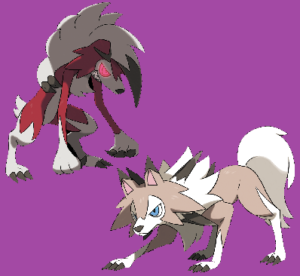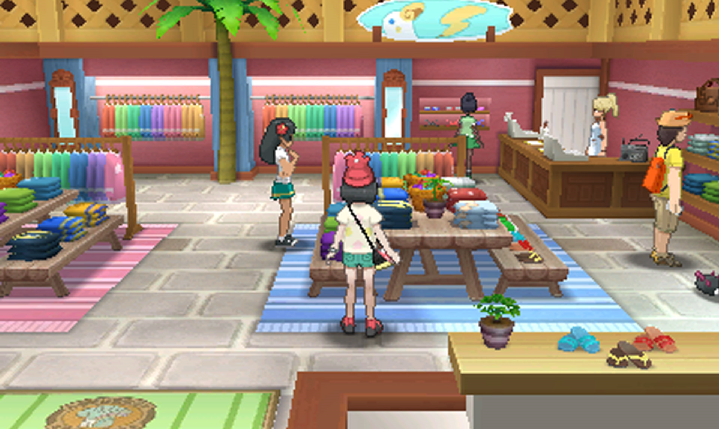The Pokémon series is currently celebrating its 20th anniversary. Many events were planned leading up to the November release of the latest main series video game entry, Pokémon Sun/Moon. Sun/Moon shake up the formula with new gameplay elements, a much easier to follow objective path in the main storyline, and more customization options than ever before. You and your mother have moved to the island paradise of Alola from the original Kanto region. Pokémon culture has developed in an entirely different way. Instead of gyms to test your might in every town, trainers are given Island Challenges. These challenges pit you against the natural and cultural elements of Alola. In a forest, you dig up ingredients for a potion. On top of a volcano, you participate in a dance ritual with Pokémon. Each challenge leads to a final battle with the Totem Pokémon, a larger, more powerful version of creature you encounter in the wild.
Beating the Totem Pokémon rewards you with a Z Crystal. These Z Crystals represent each of the 18 Pokémon types, allowing you to power up specific moves for each type in the combat system. These moves can only be used once in battle, but are far more effective than the moves in their natural state. Additional Z Crystals grant special moves for special Pokémon, like Pikachu or the starters for this generation.
 The replacement of the gym system adds a breath of fresh air to an increasingly stale format. Fighting one Pokémon (who can call on assistants) rather than a carefully constructed (and often trolly) team of Pokémon allows for more flexibility in battle. You should be able to use at least one Pokémon in your preferred party which will have at least one move that works against the Totem Pokémon. You are also warned repeatedly about what you will face by the local non-playable characters. Additionally, the location tells you what you're up against. A volcano will have some connection to fire like a cave will have a connection to ground/rock Pokémon.
The replacement of the gym system adds a breath of fresh air to an increasingly stale format. Fighting one Pokémon (who can call on assistants) rather than a carefully constructed (and often trolly) team of Pokémon allows for more flexibility in battle. You should be able to use at least one Pokémon in your preferred party which will have at least one move that works against the Totem Pokémon. You are also warned repeatedly about what you will face by the local non-playable characters. Additionally, the location tells you what you're up against. A volcano will have some connection to fire like a cave will have a connection to ground/rock Pokémon.
Pokémon Sun/Moon is clearly intended to be an introduction to new players of the game. The mapping system has never been easier to follow. Sure, the game still includes its typical dead ends funneling you in a specific direction, but the map itself actually has clear markers for your target destinations. You can see the entirety of the map from the beginning; you just don't have access to what buildings are there until you physically enter the region. More NPCs than usual offer clear advice on gameplay and elements like Pokémon Refresh and the Poké Pelago exist to make your game easier.
Pokémon Refresh is genius. You can interact with your party Pokémon whenever you want outside of battle to feed them, pet them, and make them love you more. Pokémon that love you and are full will make better moves on their own to avoid attacks or stay in battle. Further, you can heal any status condition after battle with various grooming and medical tools. You don't need antidotes and paralyz heal outside of battle anymore, saving you money for better equipment to use in the game.
 Perhaps the strangest element of Pokémon Sun/Moon leads to the need for such advanced equipment. To differentiate the games in a brand new way, the Sun and Moon titles have opposite time settings. When it is daytime in the real world, it is nighttime in Moon; Sun matches our actual clocks. Character interactions, available Pokémon, and shop availability in the new Festival Plaza are dependent on in-game time. There's even a species of Pokémon that evolves different depending on the time of day--Rockruff. Rockruff always evolves into Lycanroc, but it will only evolve at night for Moon players (the midnight form, a werewolf) and at day for Sun plays (the midday form, a wolf).
Perhaps the strangest element of Pokémon Sun/Moon leads to the need for such advanced equipment. To differentiate the games in a brand new way, the Sun and Moon titles have opposite time settings. When it is daytime in the real world, it is nighttime in Moon; Sun matches our actual clocks. Character interactions, available Pokémon, and shop availability in the new Festival Plaza are dependent on in-game time. There's even a species of Pokémon that evolves different depending on the time of day--Rockruff. Rockruff always evolves into Lycanroc, but it will only evolve at night for Moon players (the midnight form, a werewolf) and at day for Sun plays (the midday form, a wolf).
The time is a fun twist, but a frustrating one, as well. I really am not built for all night gameplay sessions anymore and found too much of the game off limits during the day in my copy of Moon. The screen also gets noticeably darker during the in-game night, making it harder to see everything.
The level of freedom, flexibility, and customization has never been higher in a Pokémon game. TMs--the technical machine moves that you must discover and learn to advance through water, air, tree, and other obstacles in Pokémon games--are gone. You have access to companion Pokémons that you can call for a ride through obstacles. A Lapras provides a slow paddle through the vast seas, while a Machamp will literally carry you in his arms while he shoves large boulders out of the way. Each of these rides has a fast and slow speed that impacts their abilities (a full speed Taurus will smash through boulders, a slow Stoutland will sniff out hidden items, etc.). Further, your party Pokémon become happier while you ride on the companion Pokémon, improving their performances in battle.
Not sacrificing your precious move slots (still limited to 4, plus the Z-move option) to break through obstacles means building more efficient teams than ever. You can build the team you want to build with the Pokémon you find, and they can all gain experience at the same time from the building. You are outfitted straight away with an Exp Share and an interactive Rotom Pokédex to guide you through the game.
The Poké Pelago gives you even more customization options. You develop islands by collecting Poké Beans, the food you can feed the Pokémon in Poké Refresh. The Pokémon in your boxes can then go to these islands to harvest beans, relax in hot springs, level up their base stats on gym equipment, cultivate berries to use in the game, and hunt for hidden treasure in caves. You can literally set your boxed Pokémon to train for 99 sessions in the gym to raise their level/HP/attack stat/etc. while you continue your journey around Alola. It's genius. You can train multiple teams at once without doing EV training or breeding/hunting for specific traits.
Then, of course, there is the character customization options. You have a choice of eight stock avatars of different skin tones and genders (only male/female, but at least there is a playable female character to start). From there, you can spend money in the salon to choose a variety of hair colors, eye colors, and hair styles to better match your ideal character. You can also visit the various shops of Alola to customize your outfit from shoes to hats and everything in between.
Once you complete the main game, a bunch of new missions open up for you. Essentially, you can spend a whole lot of time going through the most beautiful Pokémon world to date, unlocking more catchable Pokémon and gameplay modes along the way. All of the existing Pokémon will be available through trade once the Pokébank opens up next year, further expanding the variety of gameplay.
Pokémon Sun/Moon benefit immensely from a push to bring in new gamers. The fun of Pokémon games is not banging your head against the wall, trying to figure out what magical combination of events need to happen in what order to get past an obstacle that is physically not large enough to block the one path you need to advance but blocks you anyway. The fun is exploring the world, building your party, and interacting with a rich history of lore, characters, and challenges in an advanced game of Rock, Paper, Scissors.
The new features that streamline navigation while maintaining the puzzle elements of which Pokémon best serve what challenges keep loyal players like me coming back. Pokémon Sun/Moon is easily the best main game entry to date and will keep any interested player occupied for hours and hours of playtime.


